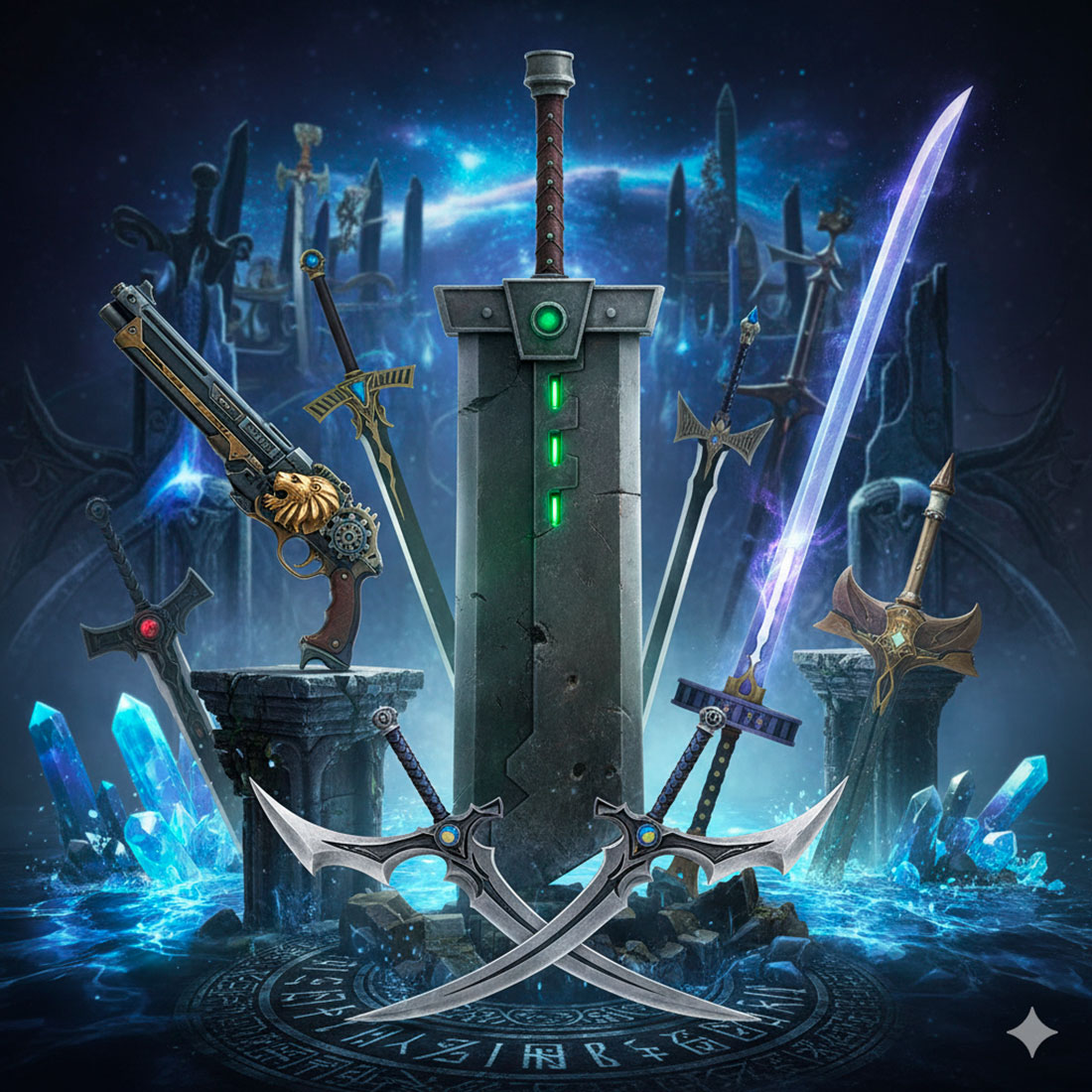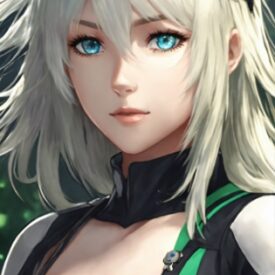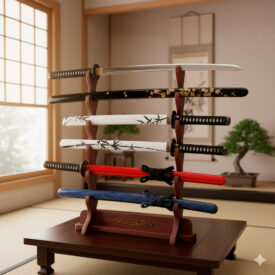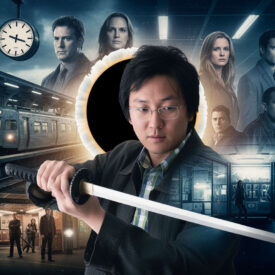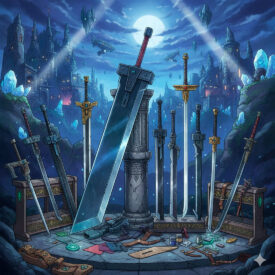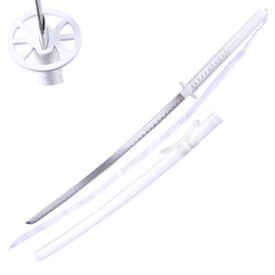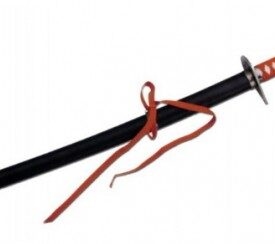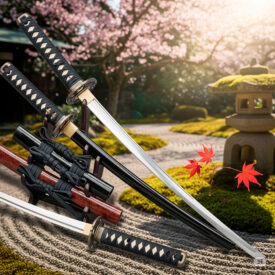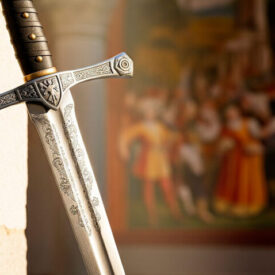In the vast universe of Final Fantasy, swords are much more than simple combat tools; they are extensions of their bearers’ souls, emblems of legend, and the beating heart of countless stories. From a hero’s colossal greatsword to a villain’s elegant katana, each blade narrates a journey, encapsulates a destiny, and defines an era. What secrets do these legendary weapons hold that make them true gaming icons?
Prepare to delve into a world where steel and fantasy merge, exploring the intrinsic design, the profound lore, and the unbreakable symbolism behind the swords that have forged Final Fantasy’s epic legacy.
A Legacy Forged in Steel and Fantasy: Final Fantasy Swords
| Era | Event |
|---|---|
| Origins and legendary forges | |
| Masamune’s Forge | A katana (nodachi) forged by a blacksmith who was corrupted by his work and massacred his village. The sword acquires a supernatural component (ability to lengthen/shorten) and is later sealed; Sephiroth retrieves it after defeating the cursed spirit. |
| Buster Sword’s Forge | The sword was forged by Angeal’s father. Angeal held it in high esteem due to his family ties and honor. |
| Legacy and transmission (before the main events of FFVII) | |
| Angeal → Zack → Cloud | Angeal bequeathed the Buster Sword to his disciple Zack Fair (along with his honor and dreams). After Zack’s death, the sword passes to Cloud, establishing the chain of possession that carries symbolic weight. |
| Final Fantasy VII: central conflict and symbols | |
| Cloud and the Buster Sword | Cloud wields the Buster Sword, an iconic symbol of the franchise. It represents brute force, the hero’s solitude, and the weight of the past; its silhouette is immediately recognizable, although in real life it would be impractical due to its size and weight. |
| Sephiroth and the Masamune | Sephiroth carries the Masamune, a colossal katana that only he can effectively wield. Its bloody origin and supernatural component make it a symbol of power and corruption; the sword also refers to the figure of Sasaki Kojirō, the counterpart to Cloud’s inspiration in Musashi. |
| Artema in FFVII | The Artema Weapon (Final Weapon) is Cloud’s ultimate weapon in FFVII: 100 Attack in that installment, and its damage scales with the bearer’s Hit Points (HP). |
| Ragnarok in FFVII | Ragnarok appears in FFVII with specific stats (97 Attack, 43 Magic/Spirit), forming part of the saga’s recurring weapons set. |
| Post-FFVII and Final Fantasy VII: Advent Children | |
| Zack’s Tomb and the Buster Sword | After Zack’s death, Cloud leaves the Buster Sword on the cliff where he died, symbolically using it as a tomb and remembrance. |
| Creation and use of the Fusion Sword | In Advent Children, Cloud replaces the Buster Sword with the Fusion Sword: a modular evolution that, when complete, retains the Buster’s shape but can split into six functional swords. Cloud uses it to execute his Omnislash V.5 technique; the sword reflects his evolution and self-expression. |
| Introduction and evolution of the Gunblade (other installments) | |
| Gunblade in FFVIII (Squall’s Revolver) | Concept created by Tetsuya Nomura: Squall’s Revolver is a sword that uses the recoil of a detonation, not firing conventional bullets, to boost slashes. It incorporates the Griever motif as an emblem and extension of Squall’s identity. |
| Gunblade in FFXIII (Lightning’s Blazefire Saber) | The Gunblade evolves into a more modular design: the Blazefire Saber has multiple modes (blade and gun mode) and can transform into a shotgun-like form, expanding its versatility in combat. |
| Legendary recurring weapons throughout the saga | |
| Excalibur (various installments) | Legendary sword associated with the Holy element and the test of valor; it appears in almost all games. Examples: in FFXII it appears stuck in a rock in the Great Crystal (allusion to the Arthurian legend); in FFIX there is Excalibur II as a variant obtainable under specific conditions. |
| Artema / Final Weapon (various installments) | Artema reappears as a supreme weapon in various installments. In FFVII it is Cloud’s final weapon (damage proportional to HP). In FFXVI it is the best sword in the game (700 Attack and Destruction) and is obtained in New Game +, forged with the «Utterance of Creation». |
| Ragnarok (various installments) | Ragnarok is another recurring sword: in FFVII it appears with specific stats, and in FFXVI it appears with great power (325 Attack and Destruction), obtainable as a reward in a side quest (e.g., «Blacksmith’s Blues IV» in FFXVI). |
The Weapons That Defined a Realm: Icons of Final Fantasy VII
Within the pantheon of legendary Final Fantasy weapons, the swords of Final Fantasy VII hold a place of honor, not only for their initial impact but also for the depth that lore has bestowed upon them over the years. They are symbols not only of power but of intertwined destinies.
The Imposing Buster Sword: The Legacy of a Hero
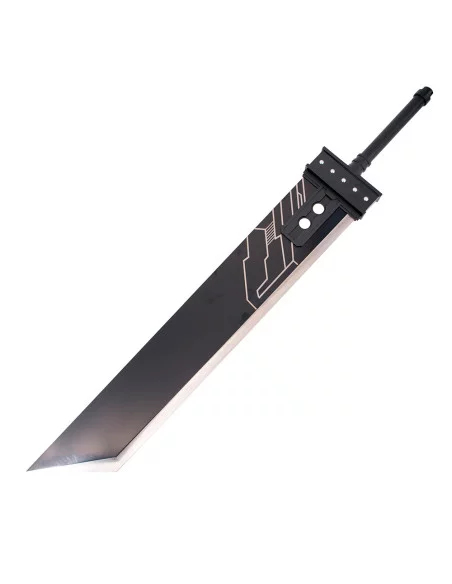 The Buster Sword, Cloud Strife’s signature weapon, is a true titan among swords. Its colossal design and minimalist, industrial appearance set it apart from any other fantasy weapon, resembling a mass of raw metal. Don’t expect flourishes; its power lies in its magnitude, an unmistakable silhouette that screams heroism and immense weight.
The Buster Sword, Cloud Strife’s signature weapon, is a true titan among swords. Its colossal design and minimalist, industrial appearance set it apart from any other fantasy weapon, resembling a mass of raw metal. Don’t expect flourishes; its power lies in its magnitude, an unmistakable silhouette that screams heroism and immense weight.
Originally, Tetsuya Nomura conceived it as “The Giant Kitchen Knife”, indirectly inspired by the saburito waster sword of the legendary swordsman Musashi Miyamoto. This sword is not just a weapon; it is a message: a testament to brute force, the hero’s solitude, and the weight of a complicated past. The Buster Sword is an inheritance, an object bequeathed to Cloud by his friend Zack Fair, who in turn received it from his mentor, Angeal Hewley. Angeal deeply valued it as a bond with his father, a symbol of his honor and dreams that passed to his successors.
Fusion Sword: Cloud’s Own Evolution
In Final Fantasy VII: Advent Children, Cloud wields the Fusion Sword, an evolution of his iconic greatsword. Although complete, it maintains the recognizable shape of the Buster Sword, this ingenious weapon can split into six functional swords, giving it unparalleled versatility on the battlefield and allowing him to execute his ultimate technique, the Omnislash V.5.
This sword is an expression of Cloud’s evolution. After leaving the Buster Sword as a tomb for Zack, the Fusion Sword symbolizes his ability to manipulate mechanics at will and adapt to his own fighting style, reflecting a new chapter in his journey as a hero.
Masamune, the Katana of Corruption: Sephiroth’s Blade
Opposite the brute force of the Buster Sword stands the lethal elegance of the Masamune, Sephiroth’s enormous katana, the main antagonist of Final Fantasy VII. Classified as a Nodachi, its design is characterized by an exceptional length that, supernaturally, is capable of changing shape (lengthening or shortening).
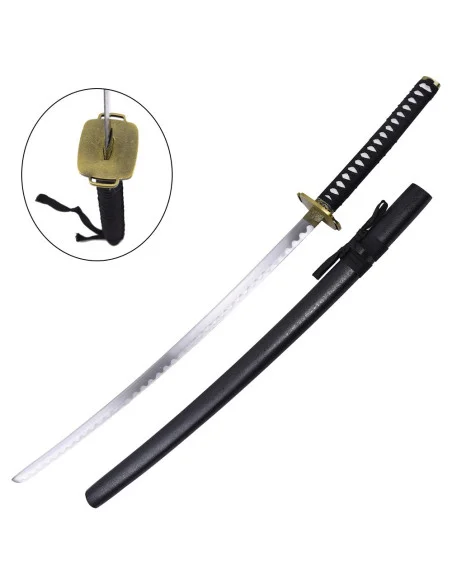 The lore of the Masamune is as dark as its wielder: forged by a blacksmith who, corrupted by his work, massacred his village. Sephiroth recovered it after defeating the cursed spirit of the blacksmith, turning it into a symbol of power and corruption. This sword is not just a weapon, but the malevolent counterpart that reflects the rivalry between Cloud (inspired by Musashi Miyamoto) and Sephiroth (inspired by Sasaki Kojirō).
The lore of the Masamune is as dark as its wielder: forged by a blacksmith who, corrupted by his work, massacred his village. Sephiroth recovered it after defeating the cursed spirit of the blacksmith, turning it into a symbol of power and corruption. This sword is not just a weapon, but the malevolent counterpart that reflects the rivalry between Cloud (inspired by Musashi Miyamoto) and Sephiroth (inspired by Sasaki Kojirō).
Beyond Midgar: Emblematic Weapons from Other Worlds
The weapon richness of Final Fantasy is not limited to a single title; throughout its installments, the saga has presented innovations and recurrences that have left an indelible mark on the imagination of players.
Gunblade: The Innovation That Broke Molds
The concept of the Gunblade burst confidently into Final Fantasy VIII, presenting a revolutionary idea by Tetsuya Nomura. Squall’s Revolver does not fire bullets conventionally, but uses the recoil of the detonation to give a devastating impulse to his slashes. More than a weapon, the Revolver is considered an extension of Squall himself, with the distinctive Griever motif (the lion emblem) engraved, symbolizing his pride and strength.
In Final Fantasy XIII, the Gunblade evolved with Lightning’s Blazefire Saber, which demonstrated greater versatility by transforming between blade and gun mode, and even adopting a shotgun-like form, showing how innovation in weapon design continued to expand combat possibilities.
The Legendary Swords That Transcended Installments
The saga is also celebrated for its legendary weapons that make recurrent appearances, often with slight variations in their power or method of obtaining, but always retaining their mythical essence:
| Weapon | Design and Appearance | Lore and Symbolism |
|---|---|---|
| Excalibur | N/A. In FFXVI it has 268 Attack and Destruction. | It is a legendary sword that appears in almost all games in the saga. It symbolizes the test of valor and is associated with the Holy element. Its existence is a direct nod to the Legend of King Arthur. In FFXII, it appears stuck in a rock in the Great Crystal, unmovable, replicating the legend. In FFIX, Excalibur II is considered the true Excalibur, and is obtained by proving the user’s worth by completing the game in less than 12 hours. |
| Artema Weapon | In FFVII it has 100 Attack. In FFXVI it is the best sword in the game with 700 Attack and Destruction. | In FFVII, it is the final weapon of Cloud and its damage is directly proportional to the character’s Hit Points (HP). In FFXVI, it is exclusive to New Game + mode (Final Fantasy Mode) and is forged with the «Utterance of Creation». |
| Ragnarok | In FFVII it has 97 Attack and 43 Magic/Spirit. In FFXVI it has 325 Attack and Destruction. | It is a recurring sword. In FFXVI, it is obtained as a reward for completing the secondary mission «Blacksmith’s Blues IV». |
Anatomy of a Legend: Design and Lore in Final Fantasy Swords
The Sword as a Symbol: More Than a Weapon, an Identity
Weapons in Final Fantasy transcend their functionality to become a powerful narrative extension of their bearers. From the sharp elegance of the Masamune to the brute force of the Buster Sword, each design is premeditated, telling a story that deepens the bond between the player, the character, and the rich lore of the game. They are symbols that evoke identity, power, and legend.
The franchise favors exaggerated and impractical designs in real life, which underscores its fantastic nature and its role as impactful visual elements. However, this factor does not diminish its popularity; in fact, fan surveys and rankings consistently place the Masamune and the Buster Sword as the most emblematic swords in the saga, their presence extending to pop culture and merchandising, where high-quality replicas are highly valued by collectors.
- Main trends and relevant data:
-
- Character symbol: The most iconic swords are intrinsically linked to the identity and development of their owners. For example, the Masamune is inseparable from Sephiroth, and the Buster Sword from Cloud.
- Exaggerated and artistic design: The franchise tends to favor impractical designs —extremely long blades, unusual shapes— to convey power or heroism.
- Deep lore: The background of each sword is often loaded with meaning, whether due to its legendary origin, its inheritance among characters, or its role in key plot events.
- Popularity: The Masamune and the Buster Sword are constantly named the most emblematic swords.
- Merchandising and collecting: High-quality replicas of the Masamune and the Buster Sword exist, which underscores their cultural impact.
Comparison table of iconic swords
| Sword | Character | Highlighted Design | Meaning in the Lore | Cultural Impact |
|---|---|---|---|---|
| Masamune | Sephiroth | Ultra-long, elegant blade | Symbol of power and destruction | Very High |
| Buster Sword | Cloud Strife | Wide, minimalist greatsword | Legacy, redemption, heroism | Very High |
| Hardedge | Cloud Strife | Toothed, aggressive blade | Powerful alternative, combative style | Moderate |
Clarifying doubts about Final Fantasy swords
What is the story behind the Masamune sword in Final Fantasy?
The Masamune sword in Final Fantasy VII is Sephiroth’s iconic weapon. Recently, its history has been expanded in Final Fantasy 7 Ever Crisis, revealing that it was forged by a blacksmith who, corrupted by his own work, massacred his village. The sword was sealed in a temple and later recovered by Sephiroth after defeating the cursed spirit of the blacksmith. The Masamune has a supernatural component that allows it to change shape, which explains its variation in size between games. This narrative adds a darker dimension to the bond between Sephiroth and the sword, making it a symbol of both power and corruption.
What characteristics make Final Fantasy swords unique?
Swords in the Final Fantasy series are unique due to several distinguishing characteristics:
- Iconism and Symbolism: Swords like Cloud Strife’s Buster Sword are iconic and symbolic, representing the character’s strength, courage, and history. They are not just weapons, but also narrative tools that evoke emotions and connections with the characters.
- Visual Design and Functionality: Final Fantasy swords often feature extravagant and striking designs, like the Buster Sword, which is shown more as a symbol than as a practical tool. This reflects the blend of fantastic elements and the focus on narrative.
- Special Properties: Some swords have unique properties that make them stand out in the game. For example, Cloud Strife’s Final Weapon in Final Fantasy VII increases its damage based on the character’s percentage of health, making it especially powerful in certain situations.
- Legacy and Inheritance: Swords can be passed between characters, such as the Buster Sword passing from Zack to Cloud, which strengthens the connection between the characters and the game’s story.
- Power and Versatility in Combat: Final Fantasy swords are usually powerful and versatile, allowing characters to perform magical or physical attacks, and often have special abilities connected to them. This makes them essential in combat and game progression.
How are Final Fantasy sword designs inspired by Japanese culture?
Final Fantasy sword designs are clearly inspired by Japanese culture, especially the tradition of forging and the symbolism of the katana. The series integrates visual and conceptual elements of legendary Japanese swords, giving them an iconographic and central narrative presence in its stories.
Visual and structural influence
Final Fantasy swords, like Sephiroth’s Masamune, are distinguished by their elongated shapes, straight or curved blades, and ornamental details, which often evoke the aesthetic of the classic Japanese katana. The long hilt, balanced blade, and attention to detail in the sheath reflect the traditional art of Japanese forging, where each sword was a personalized work of art.
Symbolism and mythology
Beyond the physical design, the use of swords in the saga is imbued with values that are also central to Japanese culture: honor, power, identity, and destiny. The katana, considered the “soul of the samurai” and a symbol of status, finds its parallel in Final Fantasy, where certain swords carry the legacy of their bearers and are associated with their personal mission or the salvation of the world.
Integration of legends and myths
Final Fantasy takes Japanese legends about divine swords, such as the Kusanagi-no-Tsurugi, which grant extraordinary powers to their owners and connect them with supernatural forces. The mythology of protective or cursed swords in the saga reflects the sacred role of weapons in Shintoism and Japanese Buddhism, where swords can cut ignorance or house divine spirits.
In summary, Final Fantasy merges the artisanal excellence and symbolism of the Japanese sword in the design and narrative of its weapons. It not only draws inspiration from the physical form of the katana but also transfers its cultural, historical, and mythical load, integrating the sword as an element of identity, power, and transcendence in each character and in the story.
Which Final Fantasy sword is considered the most powerful?
The most powerful Final Fantasy sword is generally considered the Masamune, emblematic and related to Sephiroth. However, in each game of the saga, the most powerful sword may vary, such as the Götterdämmerung in Final Fantasy XVI or the Excalibur II in Final Fantasy IX.
In general terms:
- Masamune is the most iconic and powerful sword associated with Sephiroth, with great prestige within the saga.
- In Final Fantasy XVI, the best sword is the Götterdämmerung, with high physical and magical attack parameters.
- In Final Fantasy IX, the most powerful sword is the Excalibur II, which is very difficult to obtain because it requires completing a limited-time challenge.
- The Artema and Balmung are highlighted in Final Fantasy XV as essential weapons, with Balmung being the strongest after completing the game.
Therefore, the answer depends on the specific title, but the Masamune is the most recognized as the most powerful sword in the global saga.
What is Cloud Strife’s most iconic sword in Final Fantasy?
The most iconic sword of Cloud Strife in Final Fantasy is the Buster Sword. This large, wide, and heavy sword is the character’s emblematic weapon and a recurring symbol in the franchise, recognized for its distinctive design and its narrative importance in Final Fantasy VII.
Final Fantasy swords are mirrors of their bearers’ souls, forged with a design that defies the limits of the possible and a lore that elevates them to the category of legend. They are much more than simple weapons; they are companions in adventure, narrators of destiny, and legacies of unbreakable honor. Through their blades, the saga invites us to wield not only power but also the history that defines them, demonstrating that in the Final Fantasy universe, steel and fantasy are one.
